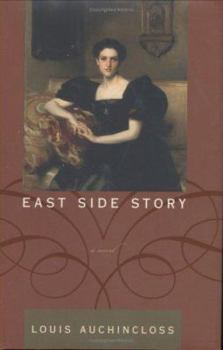East Side Story
"Louis Auchincloss has an enveloping story to tell and a perfect, understated knowledge of those who inhabit it," said the New York Times of The Scarlet Letters. The same can be said of Auchincloss's... This description may be from another edition of this product.
Format:Hardcover
Language:English
ISBN:0618452443
ISBN13:9780618452446
Release Date:January 2004
Publisher:Houghton Mifflin
Length:227 Pages
Weight:0.65 lbs.
Dimensions:0.8" x 5.8" x 8.3"
Customer Reviews
4 ratings
A VERY REWARDING READ
Published by Thriftbooks.com User , 19 years ago
I must begin by stating that the world Mr. Achincloss writes of is as alien and as far removed from my world as a world created by a SiFi writer. It is far removed from my world culturely, geographically and philosophically. That is okay though. This little book is a true pearl. Each chapter is a wonderfully crafted sketch of various members of an elite New York family, starting just before the Civil War. Mr Auchincloss certainly has a wonderful command of the language and is certainly a true story teller. This is one of those books that you can read sentence by sentence, paragraph by paragraph and relish each and every one, almost as a separate entity. I found the writing style easy on the eye and mind and the entire flow of the book was true to itself from beginning to end. A wonderful read and I highly recommend. You probably will want to purchase this one as it deserves more than one read.
Small Gem of a book.
Published by Thriftbooks.com User , 19 years ago
LIke many of Auchincloss books, ESS is a series of biographical sketches of members of the mythical Cancarhan (sp) clan, that function as individual short stories, but in their whole, make up a history of the clan (and are threaded together with references to other memebers). If you are interested in the subject: the old east coast establisment, Aunchincloss is 'authentic voice" Auchincloss has the unique ability (like Edith Warton) to both know and be his subject: the now faded anglo-saxon elite (though with a calvinist scottish flavor). he is 90 now, and i hope he has one more book in him:: what happened to the wasp elite, who have definitley lost power and influence since the 60s.
Perfect example of the genre
Published by Thriftbooks.com User , 19 years ago
Auchincloss continues to amaze me. When I saw this book in the "new fiction" stack at the library, I was astounded, since I would have thought the author would have either passed away, or at least stopped writing, a long long time ago. He began publishing his books almost 60 years ago. Although I share neither the class nor the education of this author, I have always found his books as beautiful as perfectly polished stones. They do not "live" in the way some fiction does, yet you can never forget his characters. This book is no different. It is a sort of chronicle of a family's history, starting in Scotland before the American Civil War, through immigration and settling here in the states. Each generation is seen and described by certain members of that generation. This could be very dry, yet it never fails to entertain. Golly, Mr. Auchincloss! I hope you are still serving up these books in another 20 years! Keep writing!
"The Carnochans seemed dedicated to their own permanence."
Published by Thriftbooks.com User , 20 years ago
In his fifty-ninth novel in fifty-seven years, Louis Auchincloss continues his thematic focus on the socially prominent families of New York and how they achieved their status. Beginning with David Carnochan, an immigrant from Scotland, a "good burgher with a sharp eye for a deal," who was "a granite pillar of respectability," Auchincloss traces the family through ten characters belonging to four generations, as they successively increase their fortunes and cement their places in the highest echelons of New York society. The family's pragmatism is shown when Douglas Carnochan purchases a substitute during the Civil War, while his abolitionist brother Andrew fights, is wounded, and returns to the front. Douglas's wife Eliza imposes "standards in manners and morals" on the family, and son Bruce shows how marriages are negotiated when the family's fortunes begin to fail. The reader observes the vulnerability of the family's most idealistic members, as pressure is exerted on them to remember the interests of the family and its businesses as a whole and to ignore the sometimes unethical behavior of relatives. With the characters' public and private moralities sometimes shown to be at odds, an individual family member's corporate interests often take precedence over what one would consider to be morally "right" behavior toward others. Even the family's penchant for attending the same elite schools is put under the microscope, as is the tendency to keep the wealth in the family by intermarrying with distant cousins. Showing that the family's contribution to the arts, to politics, to teaching, "to any occupation that involved giving out rather than taking in, was minimal," Auchincloss also shows that they are not enviable because of the opportunities that their wealth has given them, but sometimes to be pitied because of their limited outlooks and lack of connection to the outside (real) world. Auchincloss wisely presents a genealogical diagram at the beginning of the novel, which resembles a series of interconnected short stories, each individual's personality being obvious through Auchincloss's effective changes in tone and conversational styles as the chapters change. While the characters may not be fully rounded, they are individualized enough that the reader will remember them, as each character reveals at least one important characteristic of the family as a whole. The novel is a fascinating sociological study which shows Auchincloss's own closeness to the social milieu that he observes--honest, straightforward, and without a shred of satire. Mary Whipple






